Moon Illusion Is All in Your Head
by Bob King
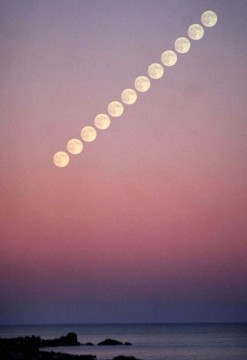
A mulitple exposure of the rising full Moon shows it's identical in size from start to finish.
Bob King
Bob King
Watch for the full Frost Moon to rise around sunset Wednesday night (November 25th), a perfect opportunity to witness one of the oldest psychological tricks known to humankind — the Moon illusion.
Even as far back as the 4th century B.C., Aristotle noted the apparent hugeness of the horizon-hugging Moon compared to it viewed overhead. Back then it was attributed to magnification by the atmosphere, but now we know it's all in our head. Photos of the rising and meridian moons show them as identical in size.
To see for yourself, take a sheet of paper and roll it up into a narrow tube. Point it at the rising Moon and adjust the tube's size until it's a little larger than the Moon's diameter. Tape the tube so its size stays the same and look at the Moon again a few hours later when it's higher in the sky. You'll see it fills the same space.
The illusion not only applies to the Moon but also to the constellations. Many observers have noticed this when viewing constellations near setting or rising compared to mental images of those same groups viewed higher up. Just the other night I caught sight of the trapezoid-shaped "Keystone" of Hercules setting in the northwest. It was huge! That was my first impression, but interestingly, the sensation faded the longer I looked.
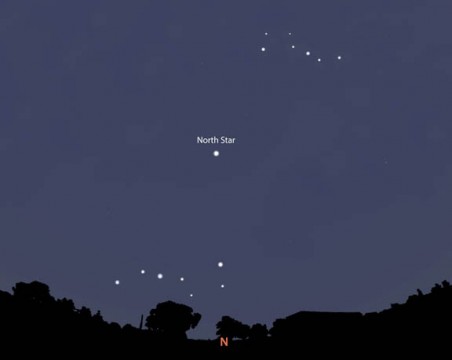
Illustration demonstrating the subjective change in the size of the Big Dipper when viewed near the horizon (7 p.m. local time in late November) and near the zenith (5 a.m.).
Stellarium
Stellarium
The Big Dipper offers one of the best examples of constellation inflation, a phenomenon you can easily see this month and next. During early evening hours, the Dipper looms large as it arcs along the northern horizon, but seems to shrink toward dawn on its climb toward the zenith.
For as long as we've seen the illusion, people have been trying to explain why it happens. There's no question it has to do with how we perceive celestial objects in a terrestrial setting, but the particulars remain elusive. So what's going on here?
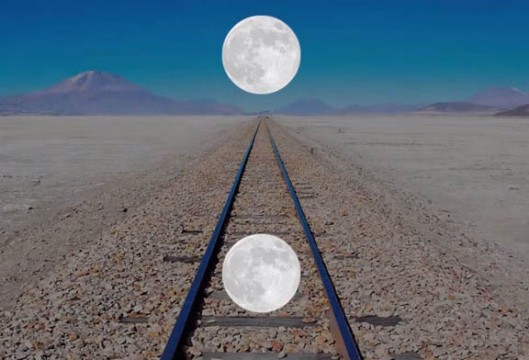
How we perceive the Moon's size has to do with how far away we think it is based on what's around it. Most of us see the top Moon, seemingly located in the distance based upon the convergence of the railroad tracks, as larger than the bottom Moo. Yet they're identical. This is known as the Ponzo illusion, discovered by Italian psychologist Mario Ponzo in 1913. In a real moonrise, it's thought that distant trees, buildings and landscape features play the role of converging lines.
NASA
NASA
In daily experience, an object overhead, say a bird or aircraft flying by, appears closer and therefore larger than the same bird or plane near the horizon because it really is closer. We're built to think that objects near the horizon are (usually) more distant than those overhead because they appear to lie behind and beyond foreground objects.
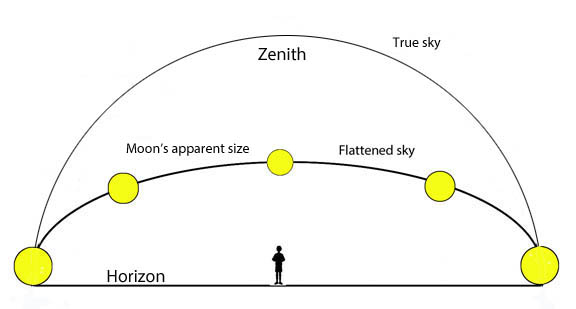
The Moon's apparent size relates to our perception of the sky as a flattened dome. When the Moon is viewed near the horizon, our brains judge it to be farther away than when seen near the zenith. Based on that assumption, we inflate its size to accommodate the false extra distance. Click graphic for more information.
Bob King
Bob King
But for extraterrestrial bodies such as the Moon, Sun and star groupings, which are identical in size whether on the horizon or at the zenith, we have no reference. Therefore, when we gaze at a horizon Moon, which clearly lies beyond every object in the foreground, our brains assume it must be farther away than the overhead version. We compensate for this perception by inflating the Moon's size. In a sense, our brains force the Moon to meet our expectations of how big it should be.
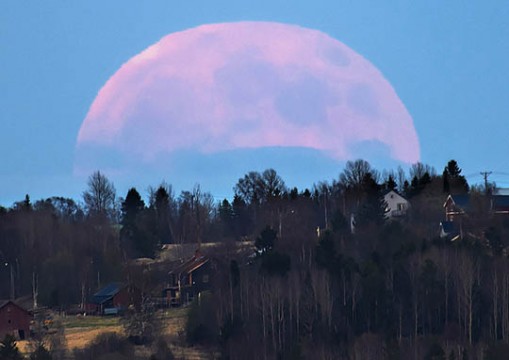
The Moon looms huge in this telephoto view taken of moonrise over the Swedish village Marieby in June 2014.
Göran Strand
Göran Strand
This perception is reinforced by yet another perception — how we see the shape of sky. Lots of us look up and imagine the sky as a flattened dome with the zenith relatively nearby and the horizon in the far distance. Our mental muscle miscalculates the Moon's distance, imagining it to be much farther off compared to its overhead distance, which brings us back to the size-forcing issue. The flattened sky perception may help explain why some airline pilots report seeing a bloated, low Moon in an empty sky with no reference but the horizon.

The "relative size" theory is yet another explanation for the difference in the Moon's apparent size, as illustrated here by the Ebbinghaus illusion.The lower central circle surrounded by small circles represents the horizon Moon with foreground objects like trees and buildings, while the upper central circle represents the zenith moon surrounded by large expanses of sky. To many, the bottom circle looks larger, but they're both the same size.
AlexWorth91 / Wikipedia
AlexWorth91 / Wikipedia
Our brains happily create powerful illusions from the moment we wake up in the morning. Think of all the rectangular and square objects we come across during the day. Unless you're staring square-on at these shapes, they should look like trapezoids of all dimensions. Do they? No — our brains still see them as squares and rectangles even when viewed up close from the side. Crazy!
What's funny in all of this is that the rising Moon is actually 1.5% smaller than when it's overhead because we have to look across the radius of the Earth — or just under 4,000 miles — at rising time. With the Moon near the zenith, we look straight into space with no Earth in the way. Perhaps the solution to the illusion lies in a mashup of perceived distance, our internal model of the sky, and the Ponzo illusion.
Other explanations abound, proving that a complete solution remains a moving target. Take a look for yourself the next few nights when the frosty Moon climbs above the eastern horizon.
Find a spot with a busy foreground and compare that impression to one made in a simpler setting where you can easily block out the foreground to show an isolated Moon relatively close to the horizon. Do both perspectives swell the Moon's apparent size equally? Then look at the Moon when it's high in the sky and recall its rising appearance. Does it look obviously smaller?
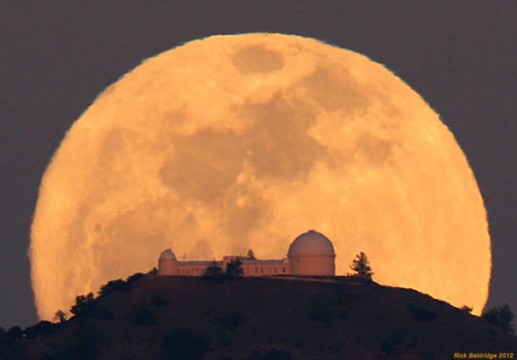
A magnificent rising Moon frames Lick Observatory atop Mt. Hamilton near San Jose, Calif. in March 2012.
Rick Baldridge
Rick Baldridge
Whether you perform these simple experiments or just feel like basking in the brilliance of the November Moon, click here for moonrise times for your location. And don't forget to watch the full Moon occult Aldebaran early Thanksgiving morning (November 26, 2015) across much of the U.S. and Canada. It occurs around 4:30 a.m. CST (5:30 EST, 3:30 MST and 2:30 PST). Talk about illusions. You'll be watching the puny 2,160-mile-diameter Moon cover a star nearly 18,000 times its size.
No comments:
Post a Comment